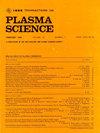氩大气压等离子体射流解离 CO$_{2}$
IF 1.3
4区 物理与天体物理
Q3 PHYSICS, FLUIDS & PLASMAS
引用次数: 0
摘要
本研究旨在探讨在室温下使用氩大气压等离子体射流(APPJ)的二氧化碳(CO2)解离率和效率。研究中使用了多种工艺参数,包括二氧化碳流速、脉冲频率和峰值电压,在此基础上评估了等离子体的特性,主要是电子温度($T_{e}$)、电子密度($n_{e}$)和二氧化碳与一氧化碳的强度比($I_{\mathrm {CO}}$ / $I_{\mathrm {CO}2}$),并将其与二氧化碳的解离率和效率结果相关联。使用光学发射光谱 (OES) 对等离子体进行了表征。在实验中,等离子体由 Ar(10 slm)和 CO2(6、9、12 和 15 sccm)组成。脉冲频率分别为 13.16 和 16.67 kHz,方波峰值电压分别为 9、9.5 和 10 kV。在测量和数值分析中,采用新开发的二氧化碳化学传感器测量了二氧化碳的解离率和效率。结果表明,由于 CO2 气体的击穿电压较高,不利于等离子体的形成,因此 CO2 流量的增加会导致等离子体密度的降低。因此,二氧化碳的解离率和效率也会降低。随着脉冲频率的增加,$n_{e}$ 将得到增强,从而促进更多的氩原子被激发或电离。这些结果将有利于提高二氧化碳的解离率。根据 $I_{mathrm {CO}}$ / $I_{mathrm {CO}2}$ 比率分析得出的结果,其趋势与测量和计算的解离效率和速率一致。综上所述,可以得出结论:在低二氧化碳流速、高脉冲频率和高峰值电压条件下,可以获得最高的二氧化碳解离率。此处获得的最高平均解离效率为 67.71%,最高平均解离率为 0.48 g/h。这是在二氧化碳输入量为 6 sccm、脉冲频率为 16.67 kHz、峰值电压为 10 kV 时获得的。本文章由计算机程序翻译,如有差异,请以英文原文为准。
Dissociation of CO2 by Argon Atmospheric Pressure Plasma Jet
The purpose of this study was to investigate the dissociation rate and efficiency of carbon dioxide (CO2) using Ar atmospheric pressure plasma jet (APPJ) at room temperature. Various process parameters, including CO2 flow rate, pulse frequency, and peak voltage, were used to study, under which the plasma characteristics, mainly electron temperature (
$T_{e}$
), electron density (
$n_{e}$
), and the intensity ratio of CO to CO2 (
$I_{\mathrm {CO}}$
/
$I_{\mathrm {CO}2}$
), were evaluated and correlated to the results of the dissociation rate and efficiency of CO2. The plasmas were characterized using optical emission spectroscopy (OES). In the experiment, the plasma consisted of Ar (10 slm) and CO2 (6, 9, 12, and 15 sccm). The pulse frequencies were 13.16 and 16.67 kHz, and the peak voltages of the square wave were 9, 9.5, and 10 kV. In the measurement and numerical analysis, the dissociation rate and efficiency of CO2 were measured by a newly developed way, which used a CO2 chemical sensor. The results show that the increase in CO2 flow rate would cause a decrease in plasma density due to high breakdown voltage of CO2 gas, which is not conducive to the formation of plasma. As a result, the CO2 dissociation rate and efficiency would also decrease. With the increase of pulse frequency,
$n_{e}$
would be enhanced to promote more Ar atoms to be excited or ionized. These results would be advantageous toward improving the dissociation rate of CO2. According to the results obtained from
$I_{\mathrm {CO}}$
/
$I_{\mathrm {CO}2}$
ratio analysis, the trends were consistent with those measured and calculated dissociation efficiency and rate. To summarize, it can be concluded that the highest CO2 dissociation rate could be obtained at a low CO2 flow rate, high pulse frequency, and high peak voltage. The highest average dissociation efficiency obtained here was 67.71%, while the highest average dissociation rate was 0.48 g/h. This was obtained when the CO2 input was 6 sccm with a pulse frequency of 16.67 kHz and a peak voltage of 10 kV.
求助全文
通过发布文献求助,成功后即可免费获取论文全文。
去求助
来源期刊

IEEE Transactions on Plasma Science
物理-物理:流体与等离子体
CiteScore
3.00
自引率
20.00%
发文量
538
审稿时长
3.8 months
期刊介绍:
The scope covers all aspects of the theory and application of plasma science. It includes the following areas: magnetohydrodynamics; thermionics and plasma diodes; basic plasma phenomena; gaseous electronics; microwave/plasma interaction; electron, ion, and plasma sources; space plasmas; intense electron and ion beams; laser-plasma interactions; plasma diagnostics; plasma chemistry and processing; solid-state plasmas; plasma heating; plasma for controlled fusion research; high energy density plasmas; industrial/commercial applications of plasma physics; plasma waves and instabilities; and high power microwave and submillimeter wave generation.
 求助内容:
求助内容: 应助结果提醒方式:
应助结果提醒方式:


